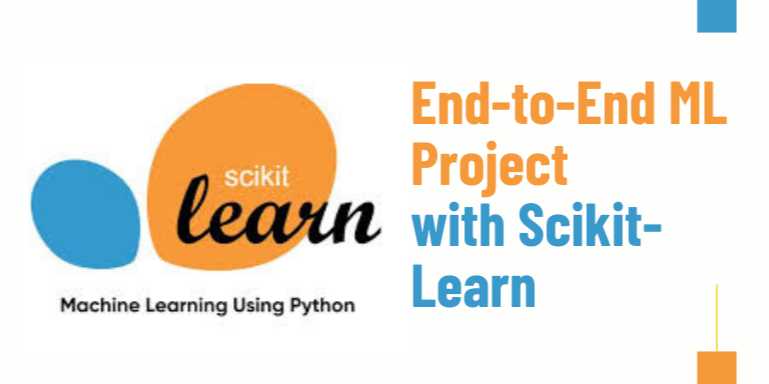A Complete End-to-End Machine Learning Project with Scikit-Learn

📖 Chapter 4: Model Training, Evaluation & Hyperparameter Tuning
🧠 Introduction
Once your dataset is cleaned, preprocessed, and enriched
with meaningful features, it’s time for the core activity of any machine
learning project: training, evaluating, and tuning models. These steps
are where your efforts begin to translate into measurable results.
In this chapter, we’ll dive deep into model selection,
training strategies, evaluation metrics, cross-validation techniques, and
hyperparameter tuning using Scikit-Learn. The goal is to build a model
that not only fits the training data but also generalizes well to unseen data —
and we’ll equip you with the tools to do exactly that.
⚙️ 1. Model Selection in
Scikit-Learn
Scikit-Learn offers a variety of algorithms for both classification
and regression problems. Choosing the right model depends on several
factors including:
- Type
of task (binary/multiclass classification, regression)
- Dataset
size and feature count
- Interpretability
needs
- Training
time constraints
- Resistance
to overfitting
🔢 Common Estimators in
Scikit-Learn
|
Task |
Algorithm |
Scikit-Learn Class |
|
Classification |
Logistic Regression |
LogisticRegression |
|
Random Forest |
RandomForestClassifier |
|
|
Support Vector Machine |
SVC |
|
|
k-Nearest
Neighbors |
KNeighborsClassifier |
|
|
Regression |
Linear Regression |
LinearRegression |
|
Random Forest |
RandomForestRegressor |
|
|
SVR (Support Vector
Regr.) |
SVR |
|
|
Ridge/Lasso
Regression |
Ridge, Lasso |
🚀 2. Model Training: The
Fit-Predict Paradigm
Training involves learning a pattern from the data and using
that to make predictions. Scikit-Learn standardizes this process through its fit
→ predict → score API.
python
from
sklearn.ensemble import RandomForestClassifier
model
= RandomForestClassifier()
model.fit(X_train,
y_train)
y_pred
= model.predict(X_test)
📊 Table: Common Methods
for Training & Prediction
|
Method |
Description |
|
.fit(X, y) |
Trains model on
features X and target y |
|
.predict(X) |
Predicts
labels for new data |
|
.score(X, y) |
Returns performance
metric (e.g., accuracy) |
|
.predict_proba(X) |
Returns class
probabilities |
🧪 3. Evaluating Model
Performance
Choosing the right evaluation metric is critical. The goal
is not just to achieve high accuracy on training data, but to ensure the model
performs well on new, unseen data.
📌 Classification Metrics
|
Metric |
Description |
Use Case |
|
Accuracy |
(TP + TN) / Total |
Balanced class
distribution |
|
Precision |
TP / (TP +
FP) |
When false
positives are costly |
|
Recall |
TP / (TP + FN) |
When false negatives
are costly |
|
F1 Score |
Harmonic mean
of precision and recall |
Imbalanced
datasets |
|
ROC-AUC |
Area under the ROC
curve |
Binary classification |
|
Log Loss |
Penalizes
confident wrong predictions |
Probabilistic
classifiers |
📌 Regression Metrics
|
Metric |
Description |
Use Case |
|
MAE |
Mean Absolute Error |
Robust to outliers |
|
MSE |
Mean Squared
Error |
Penalizes
large errors |
|
RMSE |
Root Mean Squared
Error |
More interpretable
than MSE |
|
R² Score |
Proportion of
variance explained by model |
Overall model
fit |
🔍 Example: Model
Evaluation for Classification
python
from
sklearn.metrics import accuracy_score, classification_report
accuracy
= accuracy_score(y_test, y_pred)
print(classification_report(y_test,
y_pred))
🔍 Example: Model
Evaluation for Regression
python
from
sklearn.metrics import mean_squared_error, r2_score
mse
= mean_squared_error(y_test, y_pred)
r2
= r2_score(y_test, y_pred)
🔄 4. Cross-Validation:
Reducing Variance in Evaluation
Rather than rely on a single train-test split, cross-validation
(CV) provides a better estimate of your model’s true performance by
validating it across multiple partitions of your dataset.
📌 k-Fold Cross-Validation
The dataset is split into k parts (folds). The model
is trained on k−1 parts and validated on the remaining one. This process
is repeated k times.
python
from
sklearn.model_selection import cross_val_score
scores
= cross_val_score(model, X_train, y_train, cv=5)
print(scores)
📊 Table: Cross-Validation
Techniques
|
Type |
Description |
|
K-Fold CV |
Standard split into k
partitions |
|
Stratified K-Fold |
Maintains
class balance in folds |
|
Leave-One-Out
(LOOCV) |
Uses one observation
as validation |
|
Time Series Split |
Respects
chronological ordering |
🎯 5. Avoiding Overfitting
During Training
Overfitting happens when your model learns the noise in the
training data instead of the actual signal. Some strategies to mitigate this
include:
- Using
cross-validation
- Reducing
model complexity
- Regularization
(Ridge, Lasso)
- Pruning
decision trees
- Collecting
more training data
🛠️ 6. Hyperparameter
Tuning
Hyperparameters are not learned from data but set manually.
Examples include:
- Number
of trees in Random Forest
- Learning
rate in Gradient Boosting
- Regularization
strength in Logistic Regression
📌 Grid Search
GridSearchCV tests all combinations of parameter values.
python
from
sklearn.model_selection import GridSearchCV
param_grid
= {
'n_estimators': [100, 200],
'max_depth': [10, 20]
}
grid
= GridSearchCV(RandomForestClassifier(), param_grid, cv=5)
grid.fit(X_train,
y_train)
print(grid.best_params_)
📌 Randomized Search
RandomizedSearchCV samples from the parameter space for a
faster search.
python
from
sklearn.model_selection import RandomizedSearchCV
param_dist
= {
'n_estimators': [100, 200, 300],
'max_depth': [10, 20, 30]
}
rand
= RandomizedSearchCV(RandomForestClassifier(), param_dist, cv=5, n_iter=5)
rand.fit(X_train,
y_train)
📊 Table: Grid vs
Randomized Search
|
Feature |
Grid Search |
Randomized Search |
|
Search Space |
Exhaustive |
Sampled |
|
Speed |
Slower |
Faster |
|
Use Case |
Small search space |
Large, continuous
space |
🧰 7. Integrating Tuning
into Pipelines
You can tune hyperparameters for preprocessing and modeling
steps using Pipeline.
python
from
sklearn.pipeline import Pipeline
pipeline
= Pipeline([
('scaler', StandardScaler()),
('model', LogisticRegression())
])
param_grid
= {
'model__C': [0.1, 1, 10]
}
search
= GridSearchCV(pipeline, param_grid, cv=5)
search.fit(X_train,
y_train)
🔁 8. Model Comparison
Compare different models based on:
- Cross-validation
scores
- Evaluation
metrics
- Computational
efficiency
- Interpretability
- Deployment
requirements
Use cross_val_score() for each model and compare the mean
scores.
🔄 9. Finalizing the Model
Once the best model is found:
- Retrain
on the entire training set
- Evaluate
on a holdout test set
- Save
the model using joblib or pickle
python
import
joblib
joblib.dump(best_model,
'final_model.pkl')
📊 Summary Table: Training
and Tuning Workflow
|
Step |
Tool/Class |
|
Model Selection |
RandomForest,
LogisticRegression |
|
Evaluation |
accuracy_score,
mean_squared_error |
|
Cross-Validation |
cross_val_score,
StratifiedKFold |
|
Hyperparameter Tuning |
GridSearchCV,
RandomizedSearchCV |
|
Pipeline
Integration |
Pipeline |
|
Saving Model |
joblib.dump() |
💡 Conclusion
Training a machine learning model is about more than just fitting data — it’s about evaluating generalization, tuning intelligently, and balancing complexity and performance. Scikit-Learn provides a powerful suite of tools that make this process structured, efficient, and modular.
By combining model training with best practices in
evaluation and hyperparameter tuning, you ensure that your model not only
performs well but also holds up in real-world conditions. In the next chapter,
we’ll focus on saving models, deploying them with APIs, and monitoring their
performance in production.
FAQs
1. What is meant by an end-to-end machine learning project?
An end-to-end machine learning project includes all stages of development, from defining the problem and gathering data to training, evaluating, and deploying the model in a real-world environment.
2. Why should I use Scikit-Learn for an end-to-end ML project?
Scikit-Learn is widely adopted due to its simplicity, clean API, and comprehensive set of tools for data preprocessing, modeling, evaluation, and tuning, making it ideal for full ML workflows.
3. Can I use Scikit-Learn for deep learning projects?
Scikit-Learn is not designed for deep learning. For such use cases, you should use frameworks like TensorFlow or PyTorch. However, Scikit-Learn is perfect for classical ML tasks like classification, regression, and clustering.
4. How do I handle missing values using Scikit-Learn?
You can use SimpleImputer from sklearn.impute to fill in missing values with mean, median, or most frequent values as part of a pipeline.
5. What is the advantage of using a pipeline in Scikit-Learn?
Pipelines help you bundle preprocessing and modeling steps together, ensuring consistency during training and testing and reducing the chance of data leakage.
6. How can I evaluate my model’s performance properly?
You should split your data into training and test sets or use cross-validation to assess performance. Scikit-Learn offers metrics like accuracy, F1-score, RMSE, and R² depending on the task.
7. Is it possible to deploy Scikit-Learn models into production?
Yes, models trained with Scikit-Learn can be serialized using joblib or pickle and deployed using tools like Flask, FastAPI, or cloud services such as AWS and Google Cloud.
8. What is cross-validation and why is it useful?
Cross-validation is a method of splitting the data into multiple folds to ensure the model generalizes well. It helps detect overfitting and gives a more reliable performance estimate.
9. How do I tune hyperparameters with Scikit-Learn?
You can use GridSearchCV or RandomizedSearchCV to automate hyperparameter tuning and select the best model configuration based on performance metrics.
10. Can Scikit-Learn handle categorical variables?
Yes, using transformers like OneHotEncoder or OrdinalEncoder, and integrating them within a ColumnTransformer, Scikit-Learn can preprocess both categorical and numerical features efficiently.
Tutorials are for educational purposes only, with no guarantees of comprehensiveness or error-free content; TuteeHUB disclaims liability for outcomes from reliance on the materials, recommending verification with official sources for critical applications.
Explore Other Libraries
Please allow ads on our site
Kindly log in to use this feature. We’ll take you to the login page automatically.
Login
Join Our Community Today
Ready to take your education and career to the next level? Register today and join our growing community of learners and professionals.

Your experience on this site will be improved by allowing cookies. Read Cookie Policy
Your experience on this site will be improved by allowing cookies. Read Cookie Policy
Comments(2)